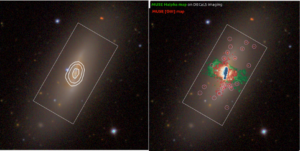Project area/s
- Local Universe
Project Details

Left: MAUVE galaxy NGC 4064, thin white contours show the MUSE observation footprint while the thick white contours show the distribution of star-forming gas. Right: A surprising population of planetary nebulae are highlighted with white circles surrounding red dots.
The motion of stars within galaxies can be typically broken down into two components: ordered rotation and random motions. Young stars (and the gas they are formed out of) typically reside in a thin, rotationally-supported disc, while older populations typically have greater contributions from random motions. Tracing the motions of these different kinematic components is key to building a picture of the gravitational potential within galaxies, and understanding how their stellar motions evolve over time. This project will take advantage of new data observed with the MUSE integral field spectrograph on ESO’s Very Large Telescope, as part of the program called MAUVE. A key scientific goal of MAUVE is to understand how galaxies die (stop their ability to form new stars), and any kinematic changes associated with this process.
While inspecting the data we found something we did not expect – visible populations of planetary nebulae (PNe). PNe are the end-stage evolution of low- and intermediate- mass stars, creating compact and highly ionized nebulae that are visible at optical wavelengths. Due to their bright nature, PNe are visible in many regions where the underlying stars are faint, giving us an independent tracer of the stellar motions, and thus gravitational potential. In this project, the student will have the opportunity to identify planetary nebulae, measure their physical properties, and use these to study the stellar motions of MAUVE galaxies.
Student Attributes
Academic Background
Basic astronomical knowledge
Computing Skills
Basic python skills, such as making plots and reading/writing files
Training Requirement
Ability to handle astronomical data and to understand the basics of observational astronomy techniques
Project Timeline
| Project timeline | |
| Week 1 | Inductions and project introduction |
| Week 2 | Initial presentation and familiarisation with MUSE data |
| Week 3 | Identification of spectral lines in MUSE cubes and creation of line maps |
| Week 4 | Identification of planetary nebulae in line maps |
| Week 5 | Extraction of PNe spectra and measurement of their emission line fluxes and kinematics (line of sight velocity, velocity dispersion) |
| Week 6 | Measurement of planetary nebulae luminosity function |
| Week 7 | Comparison of PNe kinematics with stars and gas |
| Week 8 | Comparison of PNe kinematics with stars and gas |
| Week 9 | Final presentation |
| Week 10 | Final report |

